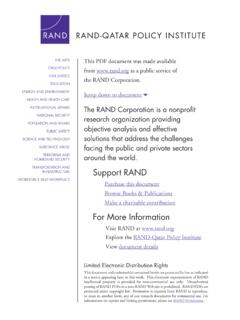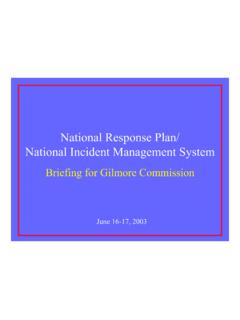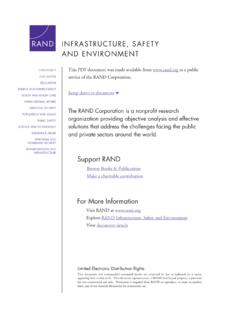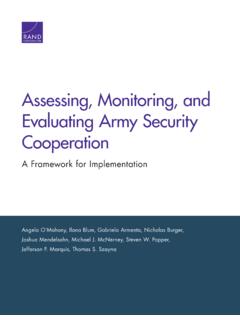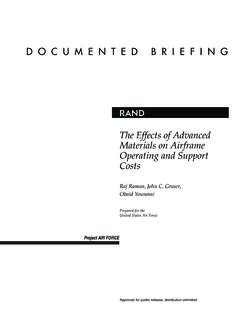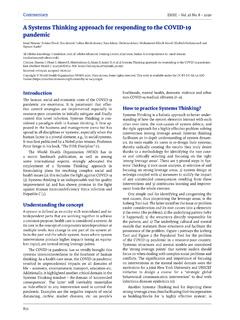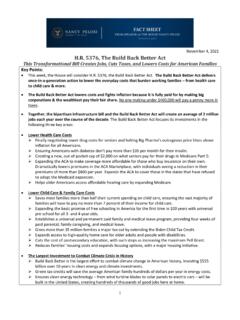Transcription of NAVY PLANNING, PROGRAMMING, BUDGETING, and …
1 navy PLANNING, programming , BUDGETING, and EXECUTIONA Reference Guide for Senior Leaders, Managers, and Action OfficersCORPORATIONIrv Blickstein, John M. Yurchak, Bradley Martin, Jerry M. Sollinger, Daniel TremblayLimited Print and Electronic Distribution RightsThis document and trademark(s) contained herein are protected by law. This representation of RAND intellectual property is provided for noncommercial use only. Unauthorized posting of this publication online is prohibited. Permission is given to duplicate this document for personal use only, as long as it is unaltered and complete. Permission is required from RAND to reproduce, or reuse in another form, any of its research documents for commercial use. For information on reprint and linking permissions, please visit RAND Corporation is a research organization that develops solutions to public policy challenges to help make communities throughout the world safer and more secure, healthier and more prosperous.
2 RAND is nonprofit, nonpartisan, and committed to the public interest. RAND s publications do not necessarily reflect the opinions of its research clients and RANDMake a tax-deductible charitable contribution at more information on this publication, visit of Congress Cataloging-in-Publication Data is available for this : 978-0-8330-9614-2 Published by the RAND Corporation, Santa Monica, Calif. Copyright 2016 RAND CorporationR is a registered photo by planning , programming , budgeting , and Execution (PPBE) process used by the Department of Defense (DoD) is time-tested and effective, but it is also complex and challenging for new personnel. Furthermore, the process changes in detail rela-tively frequently, which means that the contextual materials and instruction provided to new action officers become quickly out of date unless they remain at fairly high levels of abstraction.
3 This guidebook responds to a request from the navy to pro-duce a reference guide that documents key but enduring aspects of how the Office of the Chief of Naval Operations implements the PPBE process so that action officers, as well as flag officers and senior executives, can successfully navigate and effectively con-tribute to the process. This guide particularly emphasizes the planning and program-ming phases because these usually involve the greatest levels of effort and uncertainty, and because they are central to the principal annual deliverable a coherent, balanced Program Objective Memorandum (POM) in alignment with leadership s guidance. As this report was being prepared for publication, the R AND research team became aware that the navy is planning some changes to its POM process.
4 This guide is accu-rate as of December 2015. The guidebook is aimed at action officers, branch heads, newly assigned flag offi-cers and executives in the Office of the Chief of Naval Operations, and outside stake-holder organizations with an interest in the PPBE process and how the navy executes research was sponsored by the Office of the Chief of Naval Operations, programming Division (N80) and was conducted within the Acquisition and Tech-nology Policy Center of the R AND National Defense Research Institute, a federally funded research and development center sponsored by the Office of the Secretary of Defense, the Joint Staff, the Unified Combatant Commands, the navy , the United States Marine Corps, the defense agencies, and the Defense Intelligence more information on the R AND Acquisition and Technology Policy Center, see or contact the director (contact information is provided on the web page).
5 VContentsPreface ..iiiFigures ..viiSummary ..ixAcknowledgments ..xiiiAbbreviations ..xvCHAPTER ONEI ntroduction ..1 What OPNAV Does ..2 How This Guide Is Organized ..3 How to Use This Guide ..3 CHAPTER T WOPPBE Process Overview ..5 The Three Key DoD Decision-Support Systems ..5 Historical Perspective ..7 Interrelationships ..7 OPNAV PPBE Process ..8 Requirements Development and Approval: The JCIDS and Related Processes ..13 Defense Acquisition System ..16 Other Related Processes ..17 Summary ..19 CHAPTER THREEHow the OPNAV PPBE Process Works ..21 Key Functional Roles ..21 Process and Timeline ..25 Key Phases, Decision Points, and Deliverables ..25vi navy planning , programming , budgeting , and Execution: A Reference GuideCHAPTER FOURS takeholders, Roles, and Relationships.
6 35 Key Department of the navy Stakeholders ..35 External Stakeholders ..50 Key Relationships in the OPNAV PPBE Process ..53 CHAPTER FIVEBest Practices for Succeeding in the navy PPBE Process ..57 Understand Whose POM It Is ..57 Understand What Success Means and How to Measure It ..57 Understand the navy Program and Where Your Portfolio Fits ..58 Understand the Requirements Space ..59 Understand the Trade Space ..60 Leverage the POM Schedule and Deliverables as planning Tools ..60 Understand Stakeholder Rule Sets and How They Change over Time ..61 Understand and Exercise Your Relationships with Other Key Stakeholders ..62 Manage Expectations ..63 Pay Attention to CNO Guidance, Testimony, Speeches, and Decisions ..63 Follow the Guidance ..63 Understand How and When to Solicit and Interpret Decisions.
7 64 Avoid Surprises ..65 CHAPTER SIXP lanning for Success ..67 Have a Plan ..67 Protect the Ability to Plan ..68 Develop a Battle Rhythm ..68 Manage Participation and Engagement ..68 Develop Coherent Justification ..69 Proactively Coordinate Executive Schedules ..69 Develop the POM Theme ..70Be Prepared to Use Estimated Controls Until Well into POM Development ..70 Coordinate Controls with Anticipated Assessment Results ..71 Coordinate How the POM Will Be Defended ..71 CHAPTER SEVENC onclusion ..73 Bibliography ..75viiFigures DoD Decision-Support Systems ..6 Acquisition Process ..6 Department of Defense PPBE Timeline ..9 Simultaneous Subcycles Within DoD s PPBE Timeline ..26 Stakeholder Processes Within the PPBE Timeline ..27ixSummaryPolicies and procedures that cover how the Office of the Chief of Naval Operations (OPNAV) staff participates in the Department of Defense (DoD) s planning , programming , budgeting , and Execution (PPBE) process have been documented to varying degrees over the years.
8 This documentation typically has taken several forms, each with different objectives. First, there are various policy and procedural documents associated with preparing, submitting, and defending the annual Program Objective Memorandum (POM) submission and its supporting documentation. Second, there are policy and procedural documents associated with properly interacting with the various PPBE-related information systems that centralize and mechanize key aspects of the PPBE process and its key deliverables and supporting products, including the POM database. Third, there are training materials designed to familiarize new OPNAV staff with the background, purpose, and context of PPBE. The first two forms of documen-tation are essentially technical in nature for example, procedures, definitions, stake-holders, rules, schedules, deliverables, specifications, and formats.
9 The third form of documentation is a necessarily brief introduction to all phases of the PPBE process, the major stakeholders and their roles, the typical PPBE process flow and schedule, and the major products developed and delivered throughout a typical s programming Division (N80) identified the need for an authoritative reference guide that would fill the gap between the technical procedural documenta-tion and the courseware. Division leaders saw the need for a guide that documents key PPBE processes, decision points, products, procedures, and relationships that AOs should understand to be effective and successful in the PPBE process. The leaders also wanted to provide a reference for more-senior leaders and managers in key stakeholder organizations that either contribute to or depend on a coherent, balanced POM.
10 N80 asked the R AND Corporation s National Defense Research Institute to develop such a reference guide. This document is R AND s response to that The action officer (AO) course is a two-day introduction to PPBE. Flag officers and Senior Executive Service members get a one-day executive navy planning , programming , budgeting , and Execution: A Reference GuideIn approaching this task, the R AND team first identified the historical and refer-ence documents that would provide authoritative sources for such a guide. The team then developed a story line for the guide and interviewed subject-matter experts with extensive experience in PPBE both inside and outside of OPNAV. The resulting guide-book is aimed at AOs, branch heads, newly assigned flag officers and executives in OPNAV, and outside stakeholder organizations with an interest in the OPNAV PPBE process and how the navy executes it.

